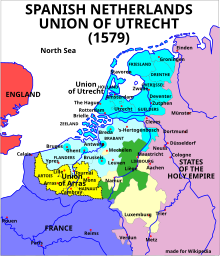| Signed | 23 January 1579 |
|---|
The Union of Utrecht (Dutch: Unie van Utrecht) was a treaty signed on 23 January 1579 in Utrecht, Netherlands, unifying the northern provinces of the Netherlands, until then under the control of Habsburg Spain.
| Signed | 23 January 1579 |
|---|
The Union of Utrecht (Dutch: Unie van Utrecht) was a treaty signed on 23 January 1579 in Utrecht, Netherlands, unifying the northern provinces of the Netherlands, until then under the control of Habsburg Spain.
The Union of Utrecht is regarded as the foundation of the Republic of the Seven United Provinces, which was not recognized by the Spanish Empire until the Twelve Years' Truce in 1609.
The treaty was signed on 23 January by Holland, Zeeland, Utrecht (but not all of Utrecht), and the province (but not the city) of Groningen. The treaty was a reaction of the Protestant provinces to the 1579 Union of Arras (Dutch: Unie van Atrecht), in which two southern provinces and a city declared their support for Roman Catholic Spain.
During the following months of 1579, other states signed the treaty as well, such as Ghent, cities from Friesland, as well as three of the quarters of Guelders (Nijmegen Quarter, Veluwe Quarter, Zutphen County). In the summer of 1579, Amersfoort from the province of Utrecht also joined, together with Ypres, Antwerp, Breda and Brussels. In February 1580, Lier, Bruges and the surrounding area also signed the treaty. The city of Groningen shifted in favor under influence of the stadtholder for Friesland, George van Rennenberg, and also signed the treaty. The fourth quarter of Guelders, Upper Guelders, never signed the treaty. In April 1580, Overijssel and Drenthe signed on.

The parts of the Low Countries that joined:[1]
Antwerp was the capital of the union until its fall to the Spanish.[2]
Flanders was almost entirely conquered by the Spanish troops, as was half of Brabant. The United Provinces still recognized Spanish rule after the Union of Utrecht. However, the union contributed to the deterioration in the relationship between the provinces and their lord, and in 1581 the United Provinces declared their independence of the king in the Act of Abjuration.
The Twelve Years' Truce of 1609 marked a pause in what became known as the Eighty Years' War, effectively acknowledging Dutch independence. As Pieter Geyl puts it, the truce marked "an astonishing victory for the Dutch," who surrendered no lands and did not agree to halt their attacks on Spanish colonies and the Spanish trade empire. In return the Spanish granted the United Provinces de facto independence by describing them as "Free lands, provinces and states against whom they make no claim" for the duration of the truce.[3]
The Union of Utrecht allowed complete personal freedom of religion and was thus one of the first unlimited edicts of religious toleration.[4] An additional declaration allowed provinces and cities that wished to remain Roman Catholic to join the union.
Many people view the Union of Utrecht as the beginning of the Netherlands as a single state. This is not entirely accurate. It can be said that the Union of Utrecht laid the foundation for the Dutch Republic, also known as the Seven United Provinces, which would be formed a few years later. However, these seven states within a state only became a unified state during the time of the Batavian Republic two centuries later.
Until the early 20th century, most Dutch and Belgian historians, such as P. L. Muller (1867) and Henri Pirenne (1911), believed that the Union of Utrecht was initially intended as a "Calvinist alliance" of the "seven" "Northern provinces" that separated themselves from the General Union (the Pacification of Ghent and the Unions of Brussels), and "seceded from the South".[5]: 454 The few Southern cities that joined the Union of Utrecht were considered more like "honorary members" rather than fully integrated members of the "Northern" Union.[6] Flemish researcher Leo Delfos further investigated and openly challenged this view from 1929 onwards.[6] He concluded that the Union of Utrecht actually sought to uphold the General Union / Pacification of Ghent of 1576 and did not intend to geographically limit itself to the North, but aimed to include all provinces in the Netherlands.[7] Both the Pacification and the Union of Utrecht were, in fact, treaties between two parties: the Calvinist-governed provinces of Holland and Zeeland and the other 'fifteen' provinces dominated by Catholics.[7] Even Alexander Farnese (Parma), the archenemy of the Union of Utrecht, denied in a letter to the States of Artois dated January 27, 1579, that the newly established Union of Utrecht had a Calvinist foundation. It was only through Parma's military conquests in the 1580s and the political developments in the rebellious region that it gradually became, in practice, a 'Northern Calvinist alliance', but it certainly did not start that way.[7]